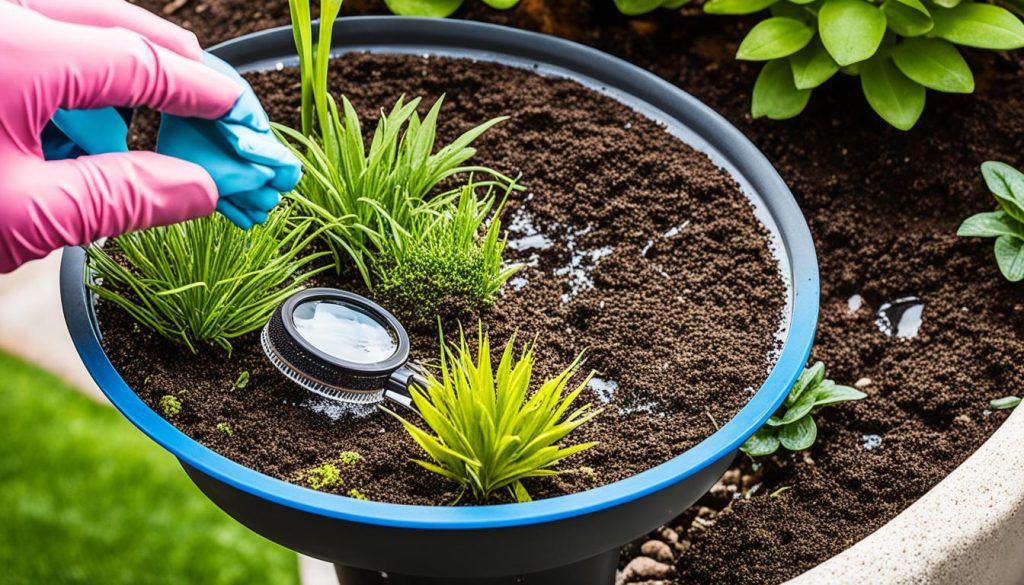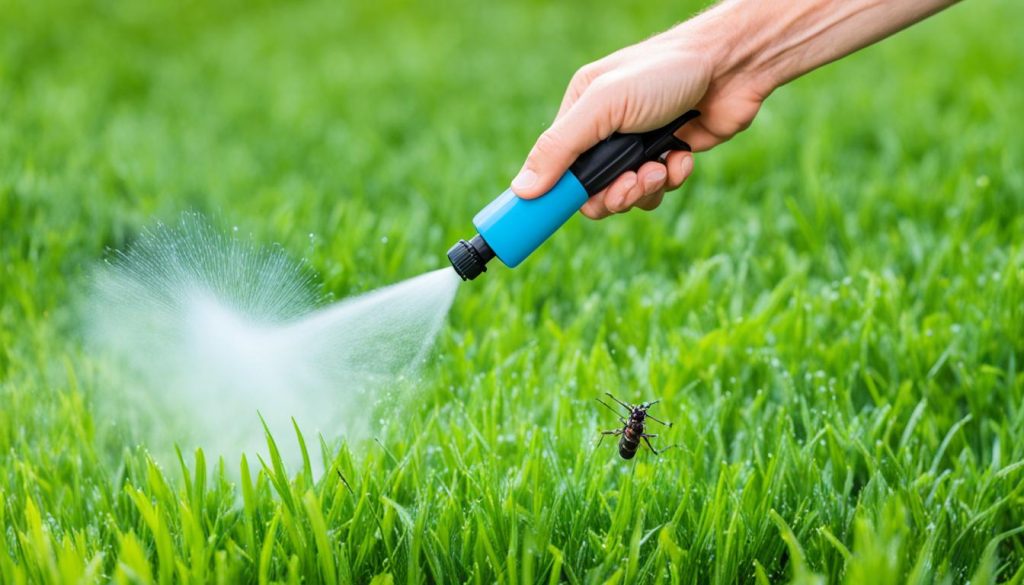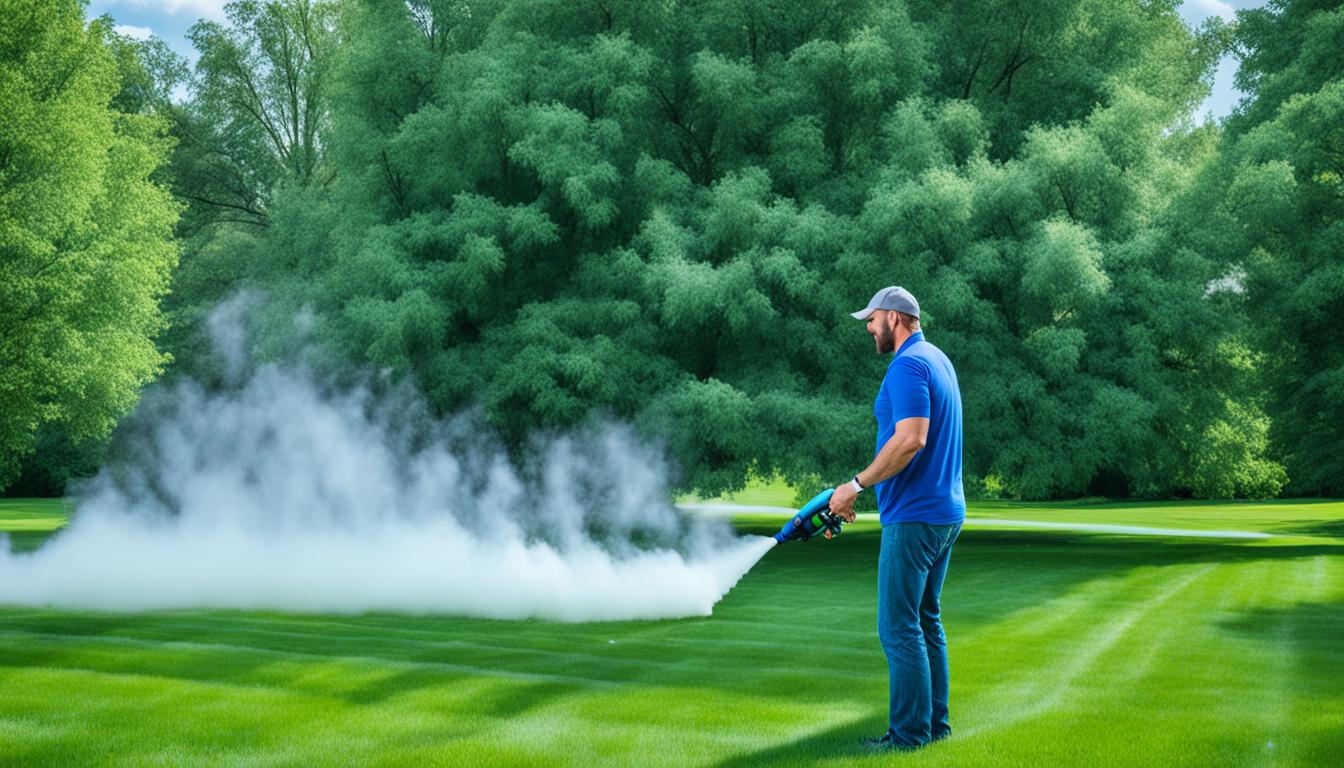Do you find yourself constantly swatting away pesky flying insects while trying to enjoy your outdoor space? Are these annoying bugs ruining your peaceful evenings or outdoor gatherings? If so, you’re not alone. Lawn gnats, also known as fungus gnats, can quickly become a nuisance in your yard, disrupting your tranquility and causing frustration. But fear not, because in this article, we will explore effective strategies to eliminate these bothersome lawn gnats and regain control over your outdoor space.
Key Takeaways:
- Understanding the appearance and behavior of lawn gnats is crucial for effective control.
- Removing breeding sites, such as overwatered areas and debris, is vital in preventing gnat infestations.
- Natural gnat control methods, like planting specific herbs and attracting natural predators, can be environmentally friendly options.
- In severe cases, the use of pesticides may be necessary, but caution should be exercised.
- Implementing proper landscaping practices and seeking professional pest control services can help manage and prevent gnat problems.
What Do Lawn Gnats Look Like?
Lawn gnats, also known as fungus gnats, are small flying insects that measure ⅛ to ¼ inch in length. These tiny pests have slender bodies, six long legs, and are typically black or dark gray in color. Their appearance is often similar to that of mosquitoes, with long, slender wings and thready antennae.
The two most common species of lawn gnats found in the United States are Badysia coprophila and Bradysia impatiens.
Image: Lawn gnat
Lawn gnats can be easily identified by their small size, slender bodies, black or dark gray color, and mosquito-like appearance. Understanding their physical characteristics is essential for accurate gnat identification and effective gnat control.
How Do Lawn Gnats Behave?
Understanding the behavior of lawn gnats is crucial in effectively controlling their population. These small flying insects have distinct habits and preferences that can guide our efforts in keeping them at bay.
Lawn gnats primarily feed on decomposing organic matter such as compost piles, nectar, and pollen. Their attraction to decaying materials is one of the reasons they can become a nuisance in outdoor spaces.
While adult lawn gnats are irritating with their constant buzzing and flying around, it is their larvae that can cause significant damage. Gnats lay their eggs in moist soil, and upon hatching, the larvae feed on organic material present in the soil, including plant roots and grass. This behavior can potentially spread diseases and lead to the deterioration of infested plants and grass.
As part of their life cycle, lawn gnat larvae undergo several stages of development before eventually emerging as adult gnats. This cycle consists of egg-laying, hatching, larval feeding, and pupation.
The table below summarizes the key behaviors and life stages of lawn gnats:
| Life Stage | Behavior |
|---|---|
| Egg-laying | Gnats lay their eggs in moist soil, often near organic matter. |
| Hatching | The eggs hatch, and the larvae emerge from the soil. |
| Larval feeding | The larvae feed on decomposing organic material, including plant roots and grass. |
| Pupation | The larvae pupate and transform into adult gnats. |
By understanding the behavioral patterns and life cycle of lawn gnats, we can tailor our gnat control strategies to effectively disrupt their breeding and feeding habits.
Remove Breeding Sites
One of the most effective ways to get rid of lawn gnats is to eliminate their breeding sites. Gnats have a preference for moist environments, so it’s crucial to address sources of excess moisture and reduce their attractiveness to these pesky insects.
To prevent gnat infestations, it’s important to:
- Reduce overwatering: Gnats thrive in overwatered turfgrass and landscape plants. To eliminate their breeding grounds, adjust your watering schedule and allow the top inch of soil to dry out between waterings.
- Clean up debris: Fallen leaves, grass clippings, and other organic matter can provide gnats with both moisture and food. Regularly clean up debris in your lawn and garden to eliminate potential breeding sites.
- Dispose of infested plants: If you notice gnat infestations on specific plants, promptly remove and dispose of them to prevent the spread of gnats to other areas of your garden.
- Address drainage issues: Poor drainage can contribute to the accumulation of moisture, creating ideal conditions for gnat breeding. Ensure that your yard has proper drainage systems in place to minimize moisture levels.
By eliminating gnat breeding sites, you can significantly reduce the likelihood of gnat infestations in your lawn and garden, making your outdoor spaces more enjoyable and gnat-free.

Use Natural Gnat Control
When it comes to eliminating lawn gnats, natural remedies and organic solutions are not only effective but also environmentally friendly. By incorporating these natural gnat control methods, you can tackle gnat problems without harmful chemicals or pesticides.
1. Plant Gnat-Repelling Herbs
Certain herbs have natural properties that repel gnats. Consider planting these herbs in your outdoor space to discourage gnats from gathering:
- Basil
- Catnip
- Chives
- Lavender
- Lemongrass
- Mint
- Rosemary
These herbs not only add beauty to your garden but also act as natural barriers against gnats.
2. Attract Natural Gnat Predators
Another effective way to control gnat populations is by attracting their natural predators. Consider implementing the following strategies:
- Install bat houses to encourage bats, which feed on gnats.
- Provide birdhouses and bird feeders to attract birds that prey on gnats.
- Plant flowers that attract hoverflies and ladybugs, which also consume gnats.
- Encourage ground beetles by creating suitable habitats such as rock piles or mulched areas.
By creating an environment that attracts natural predators, you can keep gnat populations in check.
3. Minimize Artificial Light at Night
Gnats are attracted to artificial light, especially during the evening. To reduce gnat activity around your outdoor spaces, consider the following actions:
- Minimize the use of outdoor lights during the evening.
- If lights are necessary, use yellow or amber bulbs, as these are less attractive to gnats.
By reducing artificial light, you can discourage gnats from gathering near your home.
Apply Pesticides
In severe cases of gnat infestation, chemical treatments may be necessary. Broad-spectrum insecticides, such as pyrethrin sprays or granules, can effectively target a range of insects, including gnats. These products contain active ingredients that disrupt the nervous system of the pests, leading to their demise. For indoor gnat control, foggers or bug bombs can quickly and effectively eliminate gnats in enclosed spaces.
However, it is essential to exercise caution when using pesticides. Follow the manufacturer’s instructions carefully to ensure proper application and maximize effectiveness while minimizing risks. Avoid spraying directly on flowering plants or areas where pollinators, such as bees and butterflies, are active, as pesticides can harm these beneficial insects.

Types of Pesticides for Gnat Control
There are different types of pesticides available specifically formulated for gnat control. Here are three commonly used options:
| Pesticide Type | Description | Pros | Cons |
|---|---|---|---|
| Broad-spectrum insecticides | Target a wide range of insects, including gnats | – Effective against various pests – Quick knockdown of gnats |
– Non-selective, may harm beneficial insects – Overuse can lead to pesticide resistance |
| Foggers or bug bombs | Release a fine mist or fog that penetrates indoor spaces | – Provides thorough coverage – Reaches gnats hiding in cracks and crevices |
– Can cause respiratory irritation if not used properly – Requires temporary evacuation of treated areas |
| Larvicides | Specifically target gnat larvae, disrupting their development | – Prevents larvae from maturing into adult gnats – Reduces future gnat populations |
– Limited effectiveness on adult gnats – Requires multiple applications for complete control |
It’s crucial to choose the right pesticide for your specific needs and follow all safety precautions. Consider your desired level of control, the type and severity of the infestation, and the potential impact on the environment when selecting a pesticide for gnat control.
Landscaping for Gnat Control
Preventing gnat infestations in your yard requires effective landscaping practices. By implementing these landscaping tips for gnat control, you can create an environment that is unappealing to gnats and reduces the risk of infestations.
1. Use well-draining soil: Incorporate well-draining soil in your landscape to prevent moisture accumulation, which gnats are attracted to. Proper drainage helps to reduce the breeding areas for gnats.
2. Incorporate organic matter: Adding compost or organic matter into your soil not only improves drainage but also enriches the soil. This promotes healthier plants and reduces the risk of attracting gnats.
3. Install a French drain: A French drain can redirect water away from plant roots and create an environment that is less conducive to gnat breeding. This helps to eliminate attractive breeding areas for gnats in your yard.
4. Mulch wisely and in moderation: While mulch can help retain moisture and prevent weed growth, over-mulching can create a damp environment that attracts gnats. Use mulch sparingly and keep it away from the base of plants.
5. Maintain a tidy landscape: Regularly clean up fallen leaves, grass clippings, and other organic debris. Removing these materials eliminates potential food sources for gnat larvae and reduces the risk of infestations.
6. Aerate the soil: Aerating the soil improves drainage by creating small holes that allow water to penetrate deeper into the ground. This helps to prevent excess moisture and reduces the attractiveness of your yard to gnats.
7. Rely on professional pest control: If gnat infestations persist despite your landscaping efforts, consider seeking professional pest control services. Pest control specialists have the knowledge and resources to effectively manage severe gnat problems.
Landscaping for Gnat Control Tips Summary:
- Use well-draining soil.
- Incorporate organic matter.
- Install a French drain.
- Mulch wisely and in moderation.
- Maintain a tidy landscape.
- Aerate the soil.
- Rely on professional pest control.
To create a gnat-free yard, implement these landscaping tips and maintain a consistent gnat control routine. By reducing breeding areas and creating an unfavorable environment for gnats, you can enjoy your outdoor space without worrying about annoying gnat infestations.
Rely on Professional Pest Control
In cases of overwhelming gnat infestations, it may be necessary to seek professional help. Professional pest control specialists have the expertise and resources to effectively manage severe gnat problems. They can identify the source of the infestation, eliminate gnats, and provide long-term solutions to prevent future infestations. Relying on professional pest control services can ensure that your outdoor spaces remain gnat-free.
When hiring a pest control specialist, it’s important to choose a reputable company with experience in dealing with gnat infestations. Look for professionals who are licensed and insured, as they adhere to industry standards and can guarantee the quality of their services.
Professional gnat control services offer several advantages:
- Expertise: Pest control specialists are trained to identify the species of gnats and understand their behavior. They can determine the most effective methods for eliminating gnats and preventing future infestations.
- Specialized Equipment and Products: Pest control companies have access to professional-grade equipment and effective pesticides that are not available to the general public. These products are specifically formulated to target gnats and deliver superior results.
- Safe and Environmentally Friendly Solutions: Professional pest control services prioritize the safety of your family, pets, and the environment. They employ techniques that minimize the use of chemicals and focus on environmentally friendly solutions.
- Long-Term Solutions: Pest control specialists not only eliminate current gnat infestations but also provide long-term solutions to prevent future problems. They can offer advice on managing moisture, removing breeding sites, and implementing preventative measures to keep gnats away.
By enlisting the help of professional gnat control services, you can trust that your gnat infestation will be effectively and efficiently resolved. Their expertise, specialized equipment, and long-term solutions will provide you with peace of mind and a gnat-free outdoor environment.
| Advantages of Professional Pest Control |
|---|
| Expertise in identifying gnat species and behavior |
| Access to specialized equipment and professional-grade pesticides |
| Utilization of safe and environmentally friendly solutions |
| Provision of long-term solutions to prevent future infestations |
Conclusion
Eliminating lawn gnats and managing gnat problems in your outdoor spaces can be achieved through a combination of effective strategies. By targeting breeding sites, utilizing natural control methods, and seeking professional help when necessary, you can successfully rid your lawn of these pesky insects and prevent future infestations.
Removing breeding sites is a crucial first step in gnat control. By reducing overwatering, allowing soil to dry out between waterings, and cleaning up debris, you can eliminate the moist environments that gnats thrive in. Additionally, incorporating natural remedies such as planting gnat-repelling herbs and attracting natural predators can be an eco-friendly solution to manage gnat populations.
In severe cases, the use of pesticides may be necessary to address gnat infestations. However, it’s important to carefully follow instructions and consider the impact on pollinators and flowering plants. When gnat problems become overwhelming, seeking professional pest control specialists can provide expert assistance in identifying the source of the infestation and implementing long-term solutions.
By implementing these effective strategies for eliminating lawn gnats and managing gnat problems, you can reclaim your outdoor spaces and enjoy a gnat-free environment. Remember to combine different approaches and adjust your methods based on the severity of the infestation. With persistence and the right tactics, you can successfully eliminate lawn gnats and maintain a pest-free lawn.





